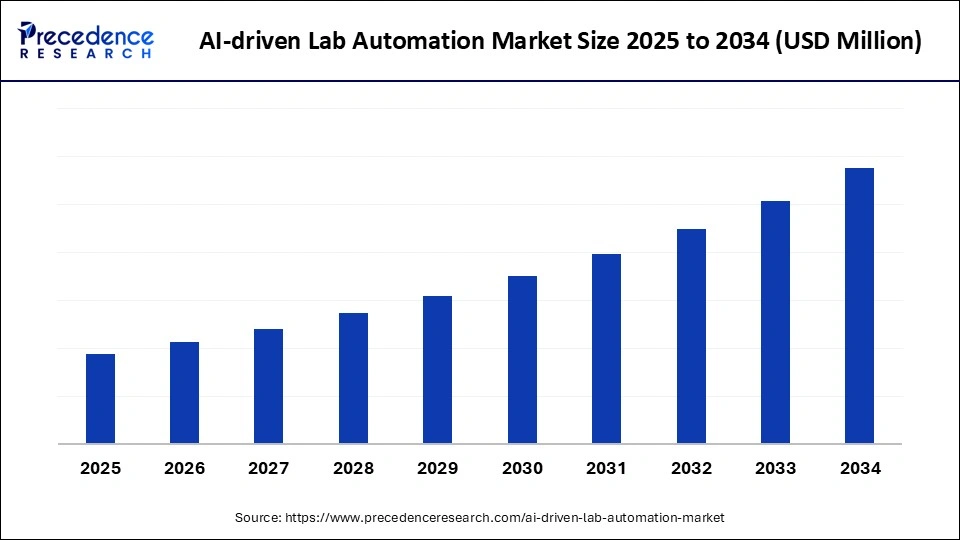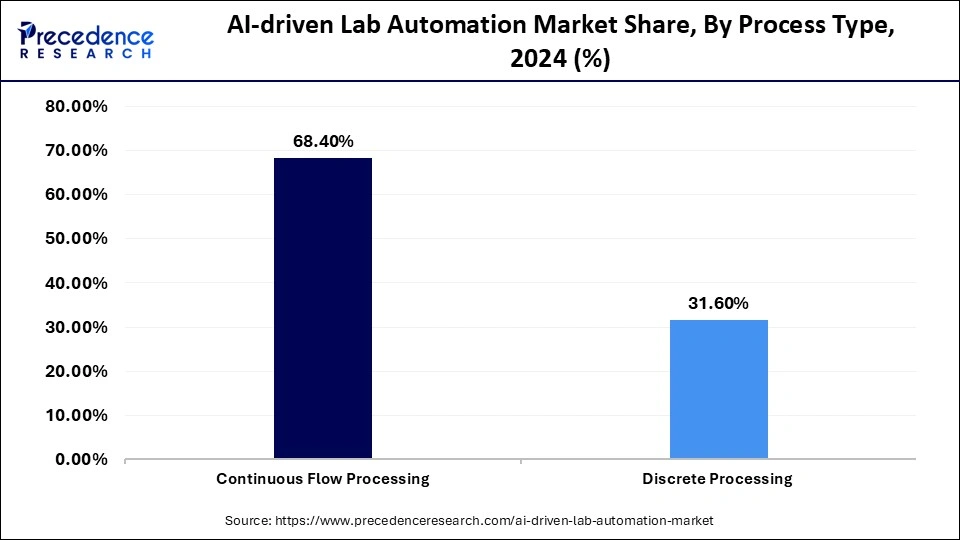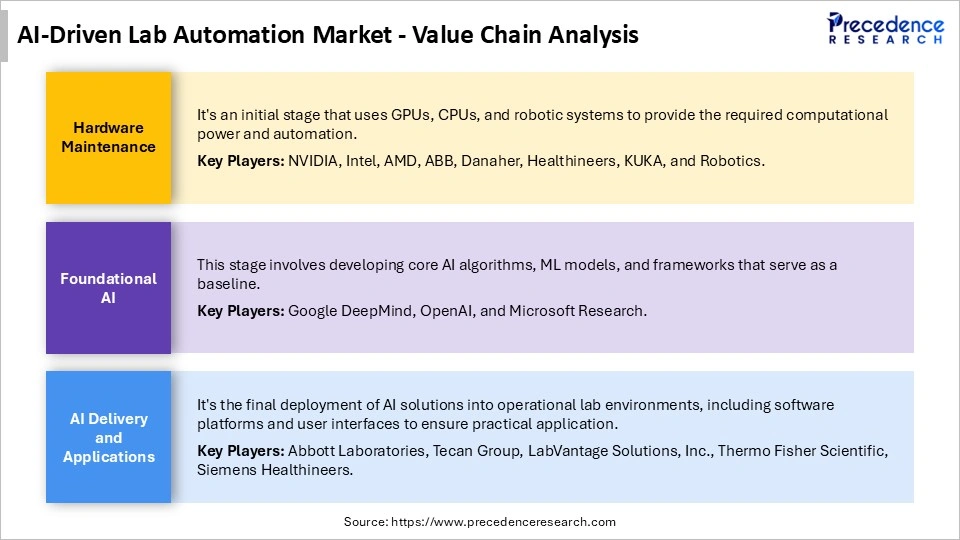List of Contents
What is the AI-driven Lab Automation Market Size?
The global AI-driven lab automation market enhances pharmaceutical and research labs with next-gen automation and machine learning.The market is expanding significantly globally as governments increase healthcare expenditure to develop and integrate AI-powered technologies to accelerate lab automation, aiming to combat rising chronic diseases with greater efficiency and lower costs.

Market Highlights
- North America accounted for the largest market share of 52.4% in 2024.
- The Asia Pacific is expected to grow at the fastest CAGR of 8.0% from 2025 to 2034.
- By process type, the continuous flow processing segment held the largest market share of 68.4% in 2024.
- By process type, the discrete processing segment is growing at a significant CAGR of 7.2% between 2025 and 2034.
- By application, the drug discovery and development segment contributed the highest market share of 43.5% in 2024.
- By application, the clinical diagnostics segment is projected to grow at a solid CAGR of 7.1% during the foreseeable period.
- By automation type, the modular automation system segment generated the biggest market share of 50.2% in 2024.
- By automation type, the total lab automation systems segment is expanding at a strong CAGR of 7.4% from 2025 to 2034.
- By end user, the pharmaceuticals & biotechnology companies segment held the largest market share of 48.5% in 2024.
- By end user, the CROs/CDMOs segment is expected to grow at a notable CAGR of 7.3% between 2025 and 2034.
AI-Powered Discovery: Accelerating Research and Innovation
AI-driven lab automation refers to laboratory systems integrating artificial intelligence, including machine learning, computer vision, and predictive analytics, with automated hardware such as robotics, liquid handlers, and sample preparation instruments, along with software to optimise tasks such as sample processing, assay execution, data analysis, and decision making. These systems help labs operate with greater consistency by standardising routine steps, reducing human variability, and enabling real-time tracking of experimental conditions. AI-powered platforms also support adaptive scheduling and workflow optimisation, which allows instruments to adjust automatically based on workload, sample priority, or observed experimental outcomes.
These solutions accelerate drug discovery, diagnostics, genomics, personalized medicine, and quality control workflows by reducing manual labour, error, and turnaround time. They enable continuous operations, support high-throughput screening, and improve the accuracy of complex analytical tasks such as image interpretation, sequencing analysis, or biomarker detection.
Digital Laboratories of the Future: Smart Workflows and Connected Systems
The market is undergoing a huge transformation, driven by technological changes such as the integration of advanced robotics, self-driving labs, digital twins, and 3D printing. The robotic system in the lab has become highly sophisticated, moving beyond basic task handling to perform complex experiments with multistep, precise outcomes. The emergence of robots collaborating with humans is increasing flexibility and adaptability, rather than following rigid, predefined manual tasks.
Future-focused innovations include self-working labs that can operate independently, enabling the AI system to design, execute, and analyze experiments with minimal human intervention. Also, the development of smaller bench-top and lab-on-a-chip automation systems enables high-quality output at lower cost by using smaller sample volumes.
AI-driven Lab Automation Market Outlook
The market is expanding primarily due to growing demand for precision, speed, and efficient outputs in research and diagnostics, which AI enables. Several key factors further propel market growth, including benefits such as automation and AI that reduce human error, provide high-quality, consistent data, and increase the reproducibility of experiments, a leading issue in scientific research.
The AI integration with lab automation primarily relates to sustainability goals, efficient energy use, waste reduction through green chemistry, and virtual labs. AI primarily optimizes lab operations and minimizes environmental impact, while automation streamlines processes, reducing material and chemical waste through precision and efficiency. These combined approaches help laboratories operate with lower resource consumption and support long-term environmental stewardship across research and diagnostic workflows.
Investment in AI-driven automation is a leading area of focus for venture capital and large corporations. Key investors are focusing on AI infrastructure, chips, and tooling amid growing compute scarcity. Leading life sciences and technology companies such as Google, Thermo Fisher Scientific, Siemens, Danaher Corp, and Healthineers are major investors that focus on developing and integrating AI into lab solutions.
Market Scope
| Report Coverage | Details |
| Dominating Region | North America |
| Fastest Growing Region | Asia Pacific |
| Base Year | 2024 |
| Forecast Period | 2025 to 2034 |
| Segments Covered | Process Type, Application, Automation Type/Solution Type, End-User, and Region |
| Regions Covered | North America, Europe, Asia-Pacific, Latin America, and Middle East & Africa |
AI-driven Lab Automation Market Segmental Insights
Process Type Insights
The continuous flow processing segment held the largest market share, at 68.4%, in 2024, due to its benefits, such as faster results and high throughput, which are highly effective for analyzing large numbers of samples with fewer chemistries. This approach supports efficient workflows by maintaining a steady sample movement through the system, reducing waiting times, and improving overall consistency. It also allows laboratories to manage peak testing periods without compromising accuracy. Continuous flow is a tried-and-true method widely used to optimize data analysis and reduce errors. The technique minimizes manual handling, supports stable reagent delivery, and ensures repeatable performance across routine and high-volume testing environments.

The discrete processing segment is expected to witness the fastest CAGR of 7.2% during the foreseeable period. The segment is expanding as it offers better sample analysis, minimized reagent waste, and enhanced flexibility for diverse sample types. These features make discrete systems ideal for laboratories that handle variable workloads and require precise control over each individual reaction step. The increasing demand for personalized medicine, which requires analyzing individual patients samples, is a major driver of discrete processing. This need supports the adoption of systems that can run patient-specific tests with higher accuracy, use tailored reagents, and provide independent processing channels.
Application Insights
The drugs discovery & development segment held the largest market share of 43.5% in 2024, driven by AI-backed experiments that increase process speed and minimize complex, multistage, and costly steps. AI can screen thousands of compounds faster than conventional methods, reducing the timeline to identify a potential drug candidate while addressing high financial risk.
The clinical diagnostics segment is expected to witness the fastest CAGR of 7.1% during the foreseeable period, as AI offers unparalleled accuracy and high-throughput diagnostics, leading to more consistent and reliable results. Automation also allows labs to process large sample volumes more quickly, ensuring timely diagnosis and treatment.
The genomic and proteomics segment is growing rapidly due to the immense complexity and data volume of these fields, which require AI and automation for high-throughput analysis, drug discovery, and personalized medicine. This shift requires high-throughput analysis, scalable genetics, and proteomic analysis. The increasing use of advanced sequencing platforms and large biomarker datasets is further boosting demand for automated systems that can manage intricate data workflows with accuracy and speed.
Quality Control / QC Labs
The quality control/QC labs segment is expanding notably as automation enhances consistency and allows data analysis in real-time while mitigating human errors, which are crucial factors for the quality control aspect of laboratories. Automation in QC provides continuous testing and analysis, reducing the time required for output and enabling faster, yet precise, experimental results.
Automation Type / Solutions Type Insights
The modular automation system segment held the largest market share of 50.2% in 2024. The segment is dominating due to modular automation systems offering greater flexibility, scalability, and cost-effectiveness, enabling labs to upgrade systems incrementally to meet specific needs. They are well-suited to dynamic research environments where experiments are continually evolving, enabling adaptation to new AI-driven applications.
The total lab automation system segment is expected to witness the fastest CAGR of 7.4% during the foreseeable period. The segment is growing as it offers enhanced efficiency, precision, and high throughput by automating the complete workflow. It helps address labor shortages by reducing operational costs associated with manual processes, reagents, and waste.
The hardware equipment (robotic arms, liquid handlers) segment is notably expanding, as hardware such as robotic arms, liquid handlers, and other crucial components are essential to AI-driven lab automation systems that provide mechanical means to execute AI-assigned tasks. It further handles toxic materials in a closed environment, minimizing human exposure during experimentation.
The software and systems segment is growing as AI-driven lab automation software and systems enable easy data collection, analysis, and modification of laboratory details, with features such as sample tracking, robust data security, and equipment management. These platforms help laboratories streamline workflows by integrating instruments, managing protocols, and reducing manual documentation. They also support real-time monitoring and automated alerts, improving operational reliability and compliance. With rising demand for scalable digital platforms, software-driven systems are becoming essential tools for modern research, diagnostics, and quality control environments.
End User Insights
The pharmaceuticals and biotechnology companies segment held the largest market share of 48.5% in 2024, driven by high R&D spending to identify potential drug candidates and by AIs ability to enhance the efficiency of this process by analyzing massive datasets. This ultimately reduces time and costs associated with developing new drugs, supporting the core targets of these sectors. AI-enabled platforms also help researchers identify promising molecular interactions and predict clinical outcomes with greater accuracy. The growing use of automation to streamline screening, optimize assays, and strengthen regulatory documentation is further reinforcing the segments market leadership.
The CROs/CDMOs segment is expected to witness the fastest CAGR of 7.3% during the foreseeable period of 2025-2034, due to the outsourcing of work to AI-enabled CROs/CDMOs, allowing major companies to focus on their core functions like R&D and marketing, which is crucial to staying competitive across the globe. AI-driven lab automation is changing laboratories from simple service providers to innovative offerors.
Clinical/Diagnostic Laboratories & Hospitals
The clinical and diagnostic laboratories and hospitals segment is growing due to the benefits of AI-driven lab automation, including enhanced accuracy and speed, improved efficiency, reduced costs, and earlier disease detection. AI can drastically enhance sample processing speed and deliver results in the minimum time, a crucial factor in emergency situations. These systems also support consistent testing quality across high-volume environments, which helps reduce manual errors and variability. In addition, integrating digital workflows and automated reporting tools enables faster clinical decision-making and better coordination between laboratory teams and medical staff.
AI-driven Lab Automation MarketRegional Insights
North America held the largest share in the AI-driven lab automation market in 2024, accounting for 52.4%, driven by several factors, including a strong research and development environment, innovation in the biotech and pharma industries, and substantial government investment to stabilize the healthcare sector. The active presence of major tech giants is also driving the regions growth substantially. The region benefits from well-established digital infrastructure that supports the large-scale deployment of automated, AI-enabled laboratory systems. In addition, strong collaborations between technology companies, academic institutions, and healthcare providers continue to accelerate innovation and adoption across clinical and research facilities.

The major trends for the U.S. AI-driven lab automation market are the integration of AI and ML across leading sectors such as R and D, the emergence of robotics and modular systems, a focus on high-throughput screening, and cloud-connected, smart laboratories with remote operations. The increasing volume of samples in drug discovery and clinical diagnostics is fueling the growth of the AI-driven lab automation market in the U.S. Laboratories are also moving toward fully digital ecosystems that unify data management, instrument connectivity, and automated analysis for improved workflow efficiency. There is a growing emphasis on predictive analytics that help anticipate equipment needs, optimize reagent use, and support proactive decision making.
Asia Pacific is expected to witness the fastest CAGR of 8.0% during the foreseeable period of 2025-2034. The region is a significant contributor to the markets growth due to significant investments by the government and private sectors in automation, along with the increasing number of laboratories in the region focused on R&D across many leading industries, such as pharma and manufacturing. The increasing incidences of fatal diseases are encouraging authorities to work deeply into the drug development as early as possible to mitigate the fatal outcomes, fueling the markets growth in the Asia Pacific.
China AI-Driven Lab Automation Market Analysis
The country is highly contributing to the growth of the Asia Pacific AI-driven lab automation market owing to the strong support by the government, including substantial investment to foster automated healthcare laboratories, a large pool of engineers working continuously to develop AI models that support laboratory automation, and the increasing expansion of pharma and biotech industries in the region.
The Europe AI-driven lab automation market is significantly expanding due to the emphasis on digital transformation rather than administrative work, leveraging AI technologies; a revolution in industrial sectors such as Industry 4.0 and smart laboratories; and a strong focus on scientific and research infrastructure. Also, regulations like GDPR are encouraging the development of innovative AI technologies by considering data privacy and security.
Germany AI-Driven Lab Automation Market Trends
Germany boasts a strong and technical, and vocational education system that supports a large number of highly skilled engineers and technicians required for AI development. Also, initiatives like Cyber Valley further help establish ML- and AI-powered robotics that can be implemented in AI-driven labs.
The Middle East and Africa AI-driven lab automation market is growing rapidly due to rising demand for diagnostics and personalized medicine, which is driving R&D in the biotech and pharma sectors, along with substantial government investments to support AI innovations across the region. The region is witnessing a growing geriatric population with chronic diseases and rising drug prices and healthcare services costs.
Many leading players are raising funding and investing to automate lab operations. Countries across the region are also building modern healthcare infrastructure and establishing specialized research hubs that enable wider adoption of automated and AI-enabled testing systems. Increased focus on digital health, telemedicine, and remote diagnostics is further driving the need for efficient, high-accuracy laboratory workflows that AI automation can support.
UAE AI-driven Lab Automation Market Trends
The UAE has a relatively robust healthcare infrastructure that has expanded rapidly over the past few years, driven by changes in lifestyles, rising disposable incomes, and demand for high-quality healthcare services. The country is further liberalizing policies that support the modernization of healthcare laboratories, leading to their automation. There is also a strong government emphasis on digital transformation in healthcare, which encourages the adoption of AI-based systems that improve accuracy and efficiency in laboratory processes.
AI-driven Lab Automation Market Value Chain

AI-driven Lab Automation Market Companies
Offers AI-enabled, end-to-end laboratory automation systems that integrate cloud-connected instruments, digital workflow orchestration, and predictive analytics. Their platforms optimize sample preparation, sequencing, and data processing for high-throughput labs.
Leverages the Danaher Business System to embed AI across its life science and diagnostics subsidiaries, including Beckman Coulter and Leica Biosystems. Their solutions enhance automated imaging, diagnostics, and complex laboratory workflows.
Provides a broad suite of robotics-based automation tools such as the JANUS liquid handling platforms, combined with AI-enabled analytics for screening, genomics workflows, and disease research. Their systems focus on precision, scalability, and reproducibility.
Offers AI-supported chromatography, mass spectrometry, and automation tools enabling smarter instrument control and predictive maintenance. Agilent integrates machine learning into sample handling and data analysis to improve laboratory throughput.
Provides automated clinical diagnostics systems that incorporate AI-driven decision support, workflow optimization, and remote monitoring. Their platforms enhance productivity in hospital laboratories and large diagnostic centers.
Specializes in automated liquid handling, centrifugation, and bioprocess systems complemented by digital and AI-enabled workflow tools. Eppendorf focuses on reliable sample management and precision automation.
A global leader in laboratory automation offering advanced robotic workstations and AI-enhanced liquid handling platforms. Tecan solutions support genomics, proteomics, diagnostics, and high-throughput screening applications.
Provides automated flow cytometry, clinical diagnostic platforms, and sample processing technologies integrated with machine learning. BD enables improved data interpretation and workflow automation in clinical and research labs.
Develops modular robotics systems for liquid handling, colony picking, and assay automation with AI-enabled scheduling software. Hudson supports flexible and scalable automation in biotech and pharmaceutical labs.
Offers high-performance robotic liquid handlers and AI-enabled workflow optimization tools used for genomics, drug discovery, and clinical diagnostics. Hamilton focuses on precision, reproducibility, and seamless digital integration.
Recent Developments
- In November 2025, IT services HCLTech launched an innovative Lab in Santa Clara, California, in a partnership with the leading tech giant NVIDIA to incubate and deploy industry applications of physical AI with cognitive robotics.(Source: https://www.business-standard.com)
- In September 2025, a leading team from mechanical engineering, chemistry, and robotics has been selected to work for the 2025 Bold Challenges Boost Cohort along with the project that is expected to establish an autonomous laboratory.(Source:https://me.engin.umich.edu)
AI-driven Lab Automation Market Segments Covered in the Report
By Process Type
- Continuous Flow Processing
- Discrete Processing
By Application
- Drug Discovery & Development
- Clinical Diagnostics
- Genomics & Proteomics
- Quality Control / QC Labs
- Others (e.g., Food & Environmental Testing)
By Automation Type/Solution Type
- Modular Automation Systems
- Total Lab Automation Systems (End-to-End)
- Hardware Equipment (robotic arms, liquid handlers)
- Software & Systems (AI algorithms, workflow orchestration)
By End-User
- Pharmaceutical & Biotechnology Companies
- Contract Research Organizations (CROs) / CDMOs
- Clinical/Diagnostic Laboratories & Hospitals
- Academic & Research Institutes
By Region
- North America
- Europe
- Asia-Pacific
- Latin America
- Middle East & Africa
For inquiries regarding discounts, bulk purchases, or customization requests, please contact us at sales@precedenceresearch.com
Frequently Asked Questions
Ask For Sample
No cookie-cutter, only authentic analysis – take the 1st step to become a Precedence Research client